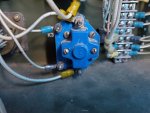- 16,766
- 24,078
- 113
- Location
- Burgkunstadt, Germany
It doesn't seem very clear, but to me it sounds like I just disconnect those four connectors and test.
Indeed, that's what it sounds like to me. The wires from terminals 1&2, 3&4 and 5&6 go to the S6, AND TB2. From TB2 the wire go to the main gen, through J-9 and J-10. If those plugs are also disconnected, then the L1 should be isolated.
Having said that, can one of you tell me what the L1 has to do with excitation? The gen set excitation is accomplished by S1. Pin 27. When the main gen has been lit off by applying 24 volts to S1-pin27, then the A1, VR is supposed to take over. Judd has told us that the gen set produces no voltage, it never gets excited. That's why I wanted him to measure VAC at pins 1&2 on the A3, Freq transducer, DURING START UP. As long as S1 is held up, voltage should go to F1 and F2, and if the exciter circuit is good, the set should produce VAC. Or am I wrong here? Am I missing something?
The L1 is hooked up to the S6, Voltage selection switch. S6 also has nothing to do with Excitation. It still sounds like L1 is not within specs. But I still do not see the correlational between L1 and excitation.
Indeed, that's what it sounds like to me. The wires from terminals 1&2, 3&4 and 5&6 go to the S6, AND TB2. From TB2 the wire go to the main gen, through J-9 and J-10. If those plugs are also disconnected, then the L1 should be isolated.
Having said that, can one of you tell me what the L1 has to do with excitation? The gen set excitation is accomplished by S1. Pin 27. When the main gen has been lit off by applying 24 volts to S1-pin27, then the A1, VR is supposed to take over. Judd has told us that the gen set produces no voltage, it never gets excited. That's why I wanted him to measure VAC at pins 1&2 on the A3, Freq transducer, DURING START UP. As long as S1 is held up, voltage should go to F1 and F2, and if the exciter circuit is good, the set should produce VAC. Or am I wrong here? Am I missing something?
The L1 is hooked up to the S6, Voltage selection switch. S6 also has nothing to do with Excitation. It still sounds like L1 is not within specs. But I still do not see the correlational between L1 and excitation.



